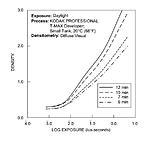Steven, sensitometric curves explain all:

So, in practice... Exposure is what it will impose how your shadows are, you have to know how shadows are at -3, -2 and -1 ( say with normal development), spot meter an scene and locate -3, -2 and -1 areas. So also the way you want your shadows it will impose exposure. You know what detail you have at -2, so perhaps you want an spot i the shadows with that detail... then just adjust exposure to have that spot at -2. You have the exposure !
You should also know how highlights are depicted at +1, +2,+3 and +4 with Normal development. With the exposure determined by the shadows then you evaluate (also with the spot meter) at what overexposure your highlights are. Say that an spot is at +5, it will be burned, but if you do a -2N development the +5 spot will move to +3, so by selecting the N you place your highlights where you want.
Just remember that the N+/- development won't move much your shadows, that are determined by the exposure only, you may have a 1/3 stop shift, so when you have placed your shadows you are free to move the highlights by adjusting N development, and this won't move shadows.
This works with any processing: regular, slimt, stand, stain... You only need the development times for each -/+N in your processing.
-/+N Development times are in tables, you can (BTZS) calibrate those times, or you simply may guess those times and trying until it works.




 Reply With Quote
Reply With Quote




 Can't wait to become a junior.
Can't wait to become a junior.

Bookmarks